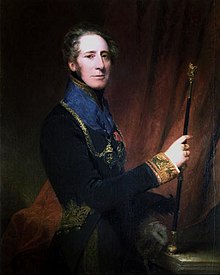Augustus Clifford
|
Admiral Sir Augustus Clifford Bt CB |
|
|---|---|
 |
|
| Gentleman Usher of the Black Rod | |
|
In office 25 July 1832 – 8 February 1877 |
|
| Monarch |
William IV Queen Victoria |
| Preceded by | Sir Thomas Tyrwhitt |
| Succeeded by | Sir William Knollys |
| Personal details | |
| Born |
Augustus William James Clifford 26 May 1788 France |
| Died | 8 February 1877 (aged 88) Palace of Westminster Westminster, Middlesex United Kingdom |
| Spouse(s) | Lady Elizabeth Frances Townshend (1813-1862; her death) |
| Relations |
The Duke of Devonshire (Father) Lady Elizabeth Foster (Mother) |
| Children | William John Cavendish Clifford |
| Awards |
Companion of the Order of the Bath Knight Bachelor Baronet |
| Military service | |
| Allegiance |
|
| Service/branch |
|
| Years of service | 1800-1866 |
| Rank |
|
Admiral Sir Augustus William James Clifford, 1st Baronet, CB (26 May 1788 – 8 February 1877) was a British Royal Navy officer, court official, and usher of the Black Rod.
Clifford was born in France in 1788, the illegitimate son of William Cavendish, 5th Duke of Devonshire (and 7th Baron Clifford) (1748–1811), and Lady Elizabeth Foster (1759–1824), daughter of Frederick Hervey, 4th Earl of Bristol. Not long after his birth, his mother brought him to England, to be wet-nursed by Louisa Augusta Marshall, wife of the Revd John Marshall, curate at Clewer, near Windsor, Berkshire. Clifford was educated at Harrow School, 1796-99. His parents married in 1809, their respective spouses having died.
He married, on 20 October 1813, Lady Elizabeth Frances Townshend (2 August 1789 – 10 April 1862 Nice), sister of John Townshend, 4th Marquess Townshend. Each of his sons, Capt William RN, Robert and Charles succeeded their father in turn as the second, third and fourth (and final) baronets.
Clifford was a patron of the arts, and formed a unique collection of paintings, sculpture, etchings, engravings, and bijouterie. He died at his residence in the House of Lords in 1877.
Clifford entered the Royal Navy as a midshipman in May 1800, and was promoted to a lieutenancy in 1806. He served at the reduction of Ste. Lucie and Tobago in 1803, and throughout the operations in Egypt during 1807. He was at the capture of a convoy in the Bay of Rosas in 1809 (for which he received a medal) and in the operations on the coast of Italy 1811–12.
...
Wikipedia
